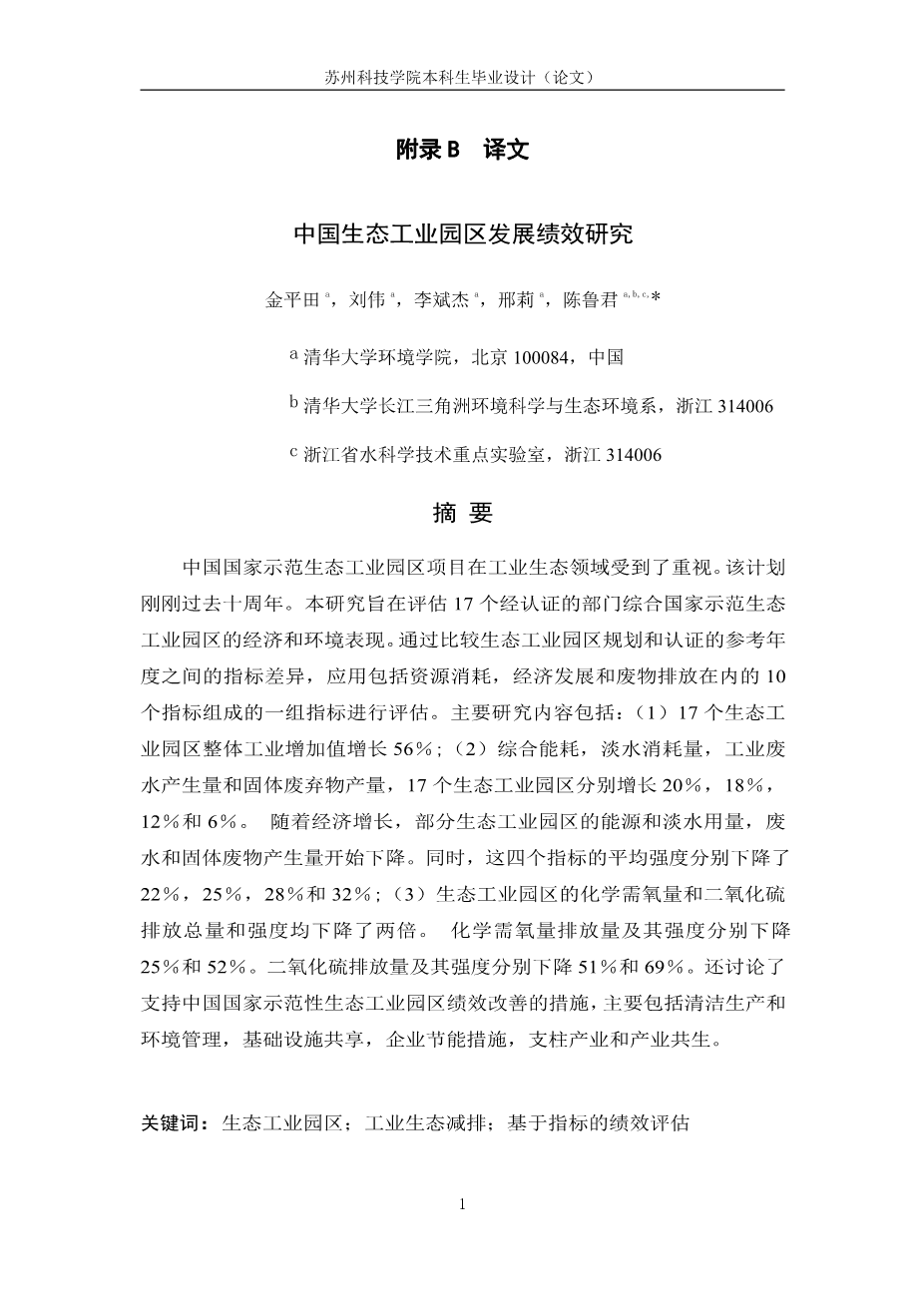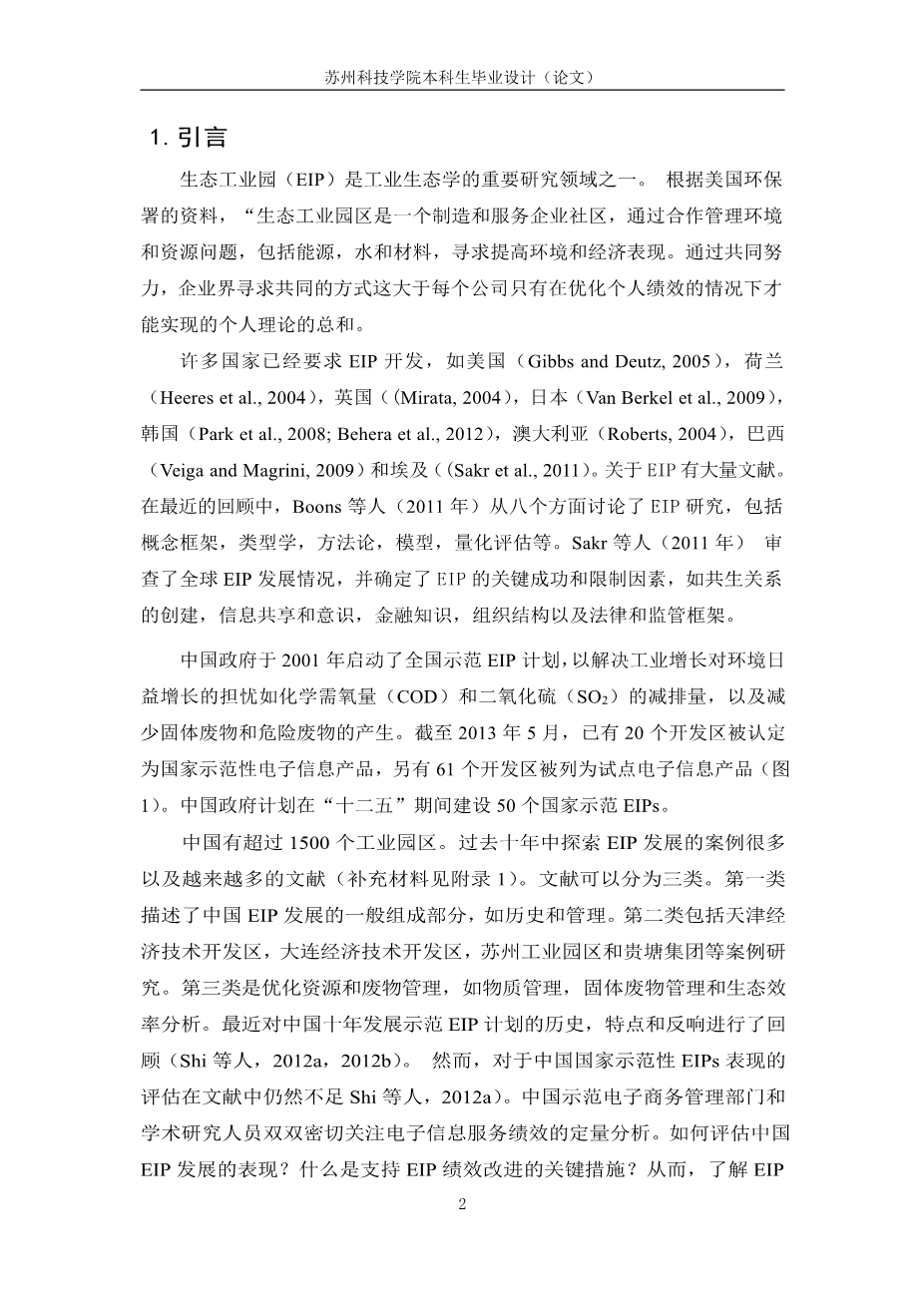附录C 外文原文
Study of the performance of eco-industrial park development in China
Jinping Tian a, Wei Liu a, Binjie Lai a, Xing Li a, Lujun Chen
a School of Environment, Tsinghua University, Beijing 100084, China
b Department of Environmental Technology and Ecology, Yangtze Delta Region Institute of Tsinghua University, 314006 Zhejiang, China
c Key Laboratory for Water Science and Technology of Zhejiang Province, 314006 Zhejiang, China
abstract
The Chinese national demonstration eco-industrial park program has received significant attentions in the field of industrial ecology. The program has just passed its ten-year anniversary. This study aims to assess the economic and environmental performance of the 17 accredited sector-integrated national demonstration eco-industrial parks. A selected group of ten metrics, including resource consumption, economic development, and waste emissions, are applied to assess the performance by comparing the difference of metrics between reference years of eco-industrial park planning and accreditation. The main findings include: (1) industrial added value of the 17 eco-industrial parks as a whole increased by 56%; (2) for comprehensive energy consumption, fresh water consumption, industrial wastewater gen- eration, and solid waste production, the 17 eco-industrial parks had an overall increase of 20%, 18%, 12%, and 6%, respectively. The quantity of energy and fresh water consumption, wastewater and solid waste generation in some eco-industrial parks started to decrease with economic growth. Meanwhile, the average intensity of the four metrics decreased by 22%, 25%, 28%, and 32%, respectively; (3) for chemical oxygen demand and sulfur dioxide, the eco-industrial parks accomplished a two-fold decrease in both total quantity of emissions and intensity. Chemical oxygen demand emissions and its intensity decreased by 25% and 52%, respectively. Sulfur dioxide emissions and its intensity decreased by 51% and 69%m respectively. Measures supporting the performance improvement of Chinese national demonstration eco-industrial parks are also discussed, which mainly include cleaner production and environmental management, infrastructure sharing, energy-saving practices at the firm level, the pillar industries, and industrial symbiosis.
Keywords Eco-industrial park Industrial ecology Emission reduction;Metrics-based;performance assessment
1、Introduction
Eco-industrial park (EIP) is one of the key research areas in in- dustrial ecology (Chertow, 2000). According to the US EPA, “an eco- industrial park is a community of manufacturing and service businesses seeking enhanced environmental and economic per- formance through collaboration in managing environmental and resource issues including energy, water, and materials. By working together, the community of businesses seeks a collective benefit. that is greater than the sum of the individual benefits each com- pany would realize if it optimized its individual performance only” (recited from (Chertow, 2000)).
Many countries have quested EIP development, such as the US (Gibbs and Deutz, 2005), Netherlands (Heeres et al., 2004), UK (Mirata, 2004), Japan (Van Berkel et al., 2009), Korea (Park et al., 2008; Behera et al., 2012), Australia (Roberts, 2004), Brazil (Veiga and Magrini, 2009), and Egypt (Sakr et al., 2011). There is a large body of literature on EIP. In a recent review, Boons et al. (2011) discussed EIP studies from eight aspects, including conceptual framework, typologies, methodologies, models, quantitative eval- uation, etc. Sakr et al. (2011) reviewed the global EIP development and identified key success and limiting factors for EIPs, such as creation of symbiotic relationship, information sharing and awareness, financial benefits, organizational structure, and legal and regulatory framework.
The Chinese government initiated a national demonstration EIP program in 2001 to address increasing environment concerns due to industrial growth (Shi et al., 2010, 2012a; Zhang et al., 2010, 2012b) such as chemical oxygen demand (COD) and sulfur dioxide (SO2) emissions reduction, and reduction of solid waste and haz- ardous waste generation. As of May 2013, 20 development zones had been accredited as the national demonstration EIPs in China, while another 61 ones listed as trial EIPs (Fig. 1). The Chinese government had planned to build 50 national demonstration EIPs in the 12th Five-Year Plan period (2011e2015) (MEP et al., 2011).
China has more than 1500 industrial parks. There exist a large number of cases for exploring EIP development during the past ten years (Shi et al., 2012a, b), as well as a growing body of liter- ature (see Appendix 1 in supplementary material). The literature can be categorized into three types. The first category describes the general components of Chinese EIP development, such as history and administration (Geng et al., 2008; Zhang et al., 2010; Zhu et al., 2010; Shi et al., 2012a, 2012b). The second category includes case studies such as the Tianjin economic-technological development area, Dalian Economic and Technological Develop- ment Zone, Suzhou
剩余内容已隐藏,支付完成后下载完整资料


英语译文共 11 页,剩余内容已隐藏,支付完成后下载完整资料
资料编号:[464526],资料为PDF文档或Word文档,PDF文档可免费转换为Word
您可能感兴趣的文章
- 基于真实完整性原则的旅游规划:以连云老区保护与开发为例外文翻译资料
- 规划一个可持续发展的新城外文翻译资料
- 历史街区与现代城市之间的有机秩序:以哈尔滨花园街历史街区概念规划为例外文翻译资料
- 中新天津生态城融资: 其他大型可持续城市项目可以吸取哪些教训?外文翻译资料
- 北印度城市土地利用动态与城郊增长特征对总体规划和城市适宜性的影响外文翻译资料
- 基于生产、生活、生态一体化的美丽乡村建设规划一以遂宁市白寨村为例外文翻译资料
- 加强区域旅游竞争力战略外文翻译资料
- “城乡统筹”和“两型社会”背景下新农村规划设计探讨:以湖南省望城县光明村规划为例外文翻译资料
- 中国农村治理体系的演变及其对农村空间规划的影响外文翻译资料
- 从繁荣到消失:宁波市双桥村的社会与空间转型外文翻译资料


